Cilantro is the most popular herb that is flavorful and easy to grow. Cilantro leaves add a distinctive flavor and aroma to any dish. Its leaves grow on long and tender stems, which can easily snip off for harvesting. Its seeds can always be harvested as the ever-popular Coriander. Although it is an acquired taste, Cilantro is loved by many people. Even if you don’t like to cook with this herb, the growing Cilantro can benefit neighboring garden plants in many ways.
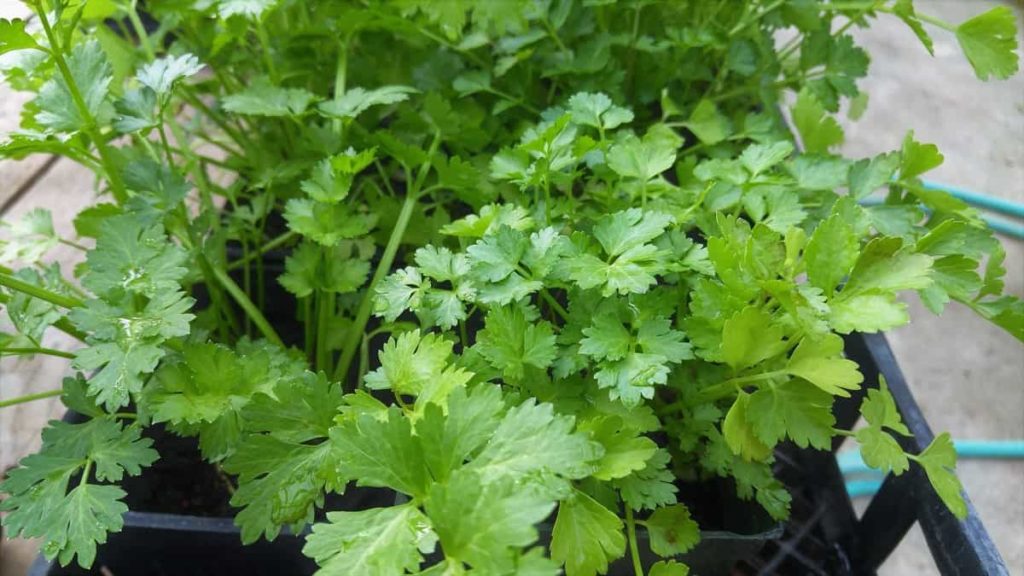
How to grow Coriander/Cilantro from seed to harvest
How long does Cilantro take from seed to harvest?
- The Cilantro leaves are ready for harvesting 45 to 70 days after planting seeds. Cut the outer leaves when they are 4 to 6 inches long. Or, cut the entire plant about 1 to 2 inches above the soil level to use both small and large leaves.
- However, seedlings in starter pots or growing kits can be ready for harvesting in just two weeks.
- Cilantro plants mature 50 to 70 days after sowing. The plant needs 100 or more days to harvest Coriander seeds. Snip Cilantro leaves for fresh use after the plant is 6 inches tall. Small immature leaves taste excellent.
How long does it take to grow Coriander from seed?
- Cilantro seeds take one to three weeks to germinate. Sow small batches every three or four weeks for a steady supply of leaves from mid-summer. The temperature will dictate how quickly the plant grows, but you should have a thin green blanket of Coriander in about a month.
- Germination takes one to two weeks, and you can usually start picking leaves about two weeks after that. Once germinated, keep the soil moist but do not allow water to accumulate, and aim for water in the morning to avoid moisture overnight.
How do you know when Coriander seeds are ready for harvest?
- Seeds are harvested after Cilantro flowers; the seeds will be ready for harvesting 2 to 3 weeks after flowering when light brown. You can allow your plant to bolt and grow seeds. Once the leaves and seeds turn brown, cut the stems from the seed heads.
- You can harvest the seeds when they are young and bright green, or you can wait for them to be harvested until they turn brown. Cut them on the green stage because their taste is faster and more obvious and because the only place you can find green Coriander seeds is in a garden.
- You should hang the Cilantro stems upside down in a paper bag in a dry place. Once the seeds ripen, they will fall into the bag. The green Coriander flavor is sharper and more pungent than the mature seeds.
How many harvests can you get from Cilantro?
- Until the plant starts flowering, it will only continue to grow leaves, and you can keep picking them. Although most Cilantro plants only live a few months, it should guarantee at least 2 or 3 harvests from a single plant if you’ve timed your seeding right.
- You should harvest Cilantro about once a week. If the plant grows well, you can harvest more often. Either way, you’ll need to harvest Cilantro at least once a week to help prevent bolting.
In case you missed it: 18 Common Cilantro/Coriander Plant Problems: How to Fix Them, Solutions, and Treatment
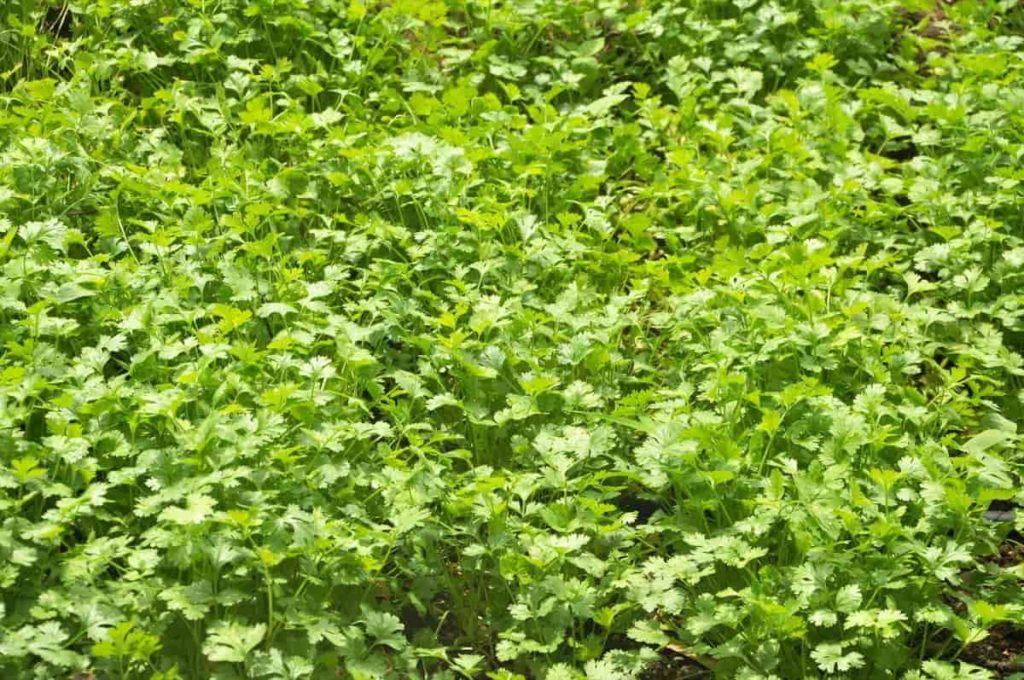
Does Cilantro grow back after cutting?
- The Cilantro that is cut back entirely will eventually grow back, but you only cut what you need at one time to encourage vigorous growth. If Cilantro is grown in ideal conditions with regular crops, the same plant will continue to produce for several weeks.
- Cilantro is very easy to grow and doesn’t require any special attention or care. Cilantro leaves will continue growing back for many more crops when appropriately pruned.
- Cilantro is an annual herb, but its re-seeds itself well. If you allow your Cilantro plants to flower and go to seed, they will easily re-seed themselves. In mild climates, you can get 2 to 3 cycles of Cilantro in one season due to the short life cycle of Cilantro.
- Pinch the young Cilantro plants back an inch or more to encourage full, bushy plants. Cut off the top of the main stem as soon as it appears to produce flower buds or seed pods. Cutting the heads of flowers brings the energy of Cilantro plants back into the leaf, not the production of flowers or seeds.
- Harvest early and often to encourage further growth. Don’t harvest all the leaves from the same plant simultaneously; leave enough so the Cilantro can grow further.
When should Cilantro be pruned?
- Cilantro leaves need 60 to 75 days to reach a suitable size for the first crop. Start pruning the outer leaves from the plant when it is about 6 inches high. Do not cut the inner leaves; instead, place them on the plant so that the Cilantro can continue to grow and produce until flowering.
- Prune the stems from your Cilantro plant by only one-third; cutting more than that can inhibit its growth. Yellow or brown seed pods may form when Cilantro goes to seed.
- Cilantro should be pruned frequently to encourage new growth. The old, large Cilantro leaves are also more bitter, making the herb less desirable if left to grow.
Should I crush Coriander seeds before planting?
- You can easily grow Coriander from the seeds bought at the grocery store, provided the seeds are fresh and do not have any other treatments. Unless the seeds are too old, you should have very little if there is a problem growing Coriander seeds in the grocery store.
- The husk is hard, round, and light brown or gray. Before you plant them in the ground, you must prepare Cilantro seeds to increase their chances of germination. Gently crush the seed husk by holding the two seeds together.
- You can do this by holding two seeds between your index finger and thumb and pressing up to the outer shell cracks. Once you have prepared your seeds, soak them in water for 2 to 4 days.
How do you get a continuous supply of Cilantro?
- Sow a pinch of Cilantro seeds every three weeks during the season to maintain a steady supply of tender leaves. Search for bolt-resistant Cilantro types, which are more heat-tolerant. In addition, cilantro is easy to grow and sows itself freely.
- The seed variety will produce seeds faster than the leaf type, but once a plant runs towards the seed, it will stop leaf production. Therefore, you will have less picking time if you want Coriander leaves for cooking. All varieties will eventually produce seeds, but leaf varieties will last longer.
- Keep the soil or compost moist because if it is allowed to dry, it runs towards the seed, but take care not to have too much water as it can lead to rot, especially in autumn and winter. Give the plants a light liquid dose of a general feed every two weeks in late spring and summer.
- You should plant new seeds every six weeks to keep a constant supply in the growing season. Cilantro will also seed again in many zones. Once the Cilantro plants have bolted, let them go to seed, and they will regrow for you next year, or collect the Cilantro seeds and use them as Coriander in your cooking.
Does Cilantro need a lot of sun?
- The garden growing conditions for Cilantro are very similar to almost all other vegetables and herbs. A lightly and well-drained soil with generous amounts of organic matter is beneficial.
- Cilantro thrives on 4 to 6 hours of direct sunlight daily. Therefore, it will retain its flavor when your Cilantro temperature is grown from 18°C to 24°C. However, cilantro will be exposed to too much heat and will bolts, which causes it to flower and die.
- Outside, Coriander prefers a cool position, light shade, and well-drained soil. Coriander is often grown in a pot in a slight shade in the yard or on a window that does not receive directly burning summer sunlight and does not heat much.
- The Cilantro will bolt faster and set the seeds under hot sunlight, so this herb likes it a bit. Grow it directly from the seed after the possibility of frost has passed, Cilantro produces a large taproot and hates transplantation.
Is Cilantro an annual or perennial?
- Cilantro is annual, although it can survive winter in mild climates. However, if you allow some seeds to fall from the adult plant after it flowers, new Cilantro plants may sprout as temperatures cool in the fall. And baby Cilantro plants can pop up next spring without your help.
- Therefore, it will only survive for a few months, depending on your climate, in the cool spring, autumn, or winter. If the temperature is too hot, it won’t last long. Growing Cilantro gives you two products: one as a fresh herb and one as a spice (Coriander). Plus, it’s much easier to grow once you get the hang of it.
In case you missed it: Coriander Growing Tips, Techniques, and Secrets
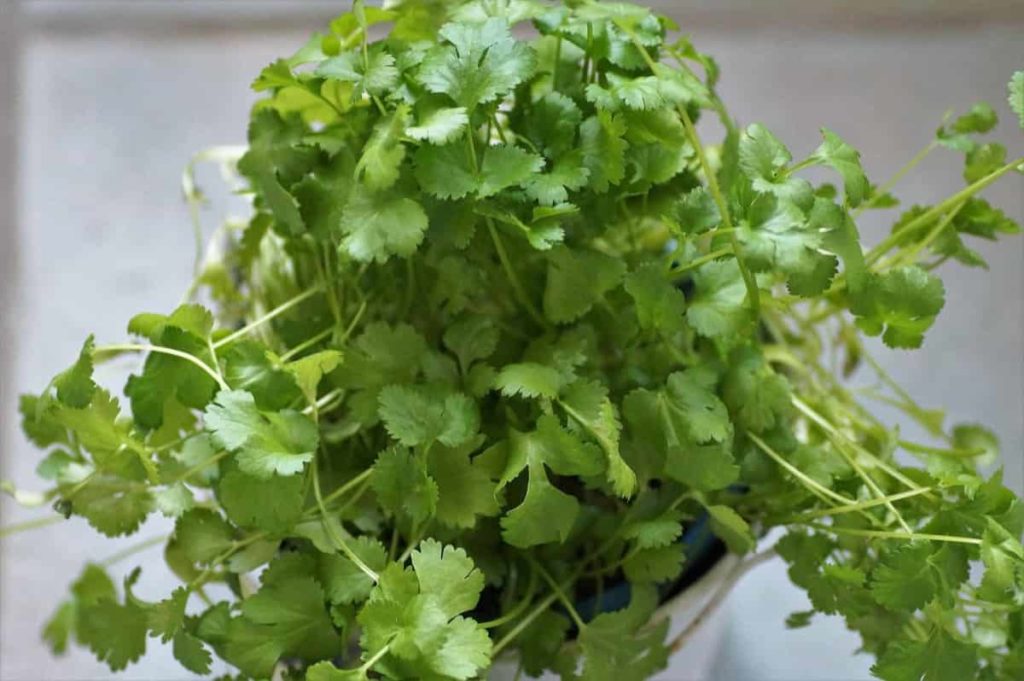
Why is my Cilantro growing so tall?
- Cilantro plants perform well in cold weather. Cilantro will send long shoots that will flower when the weather gets warmer, indicating that their harvest season is over. Plant Cilantro in its place so that it can seed again.
- Pinch each straight stem tip when the plant grows to 4 to 6 inches. Cut off the outer leaves when the leafy stems are 4 inches long. Repeated cutting and pinching keep the Cilantro compact and slow bolting if the temperature remains cool.
What is the secret to growing Coriander?
- Coriander doesn’t like to be moist and will work better in dry rather than humid areas. A light, well-drained soil is excellent, with protection from sun and wind. Sow some seeds every fortnight, so you have a constant supply, and space the seeds at a distance of 20 to 30 centimeters.
- Grow Cilantro in full the sun, although it will also tolerate a light shade in the south and southwest where the sun is intense. Plant in the south and southwest in autumn or early spring, about a month before the last frost.
- Cilantro thrives in cold weather, and extremely hot weather will cause it to flower and go to seed. The flavors of the leaves change at this time in the plant’s life cycle, although you can still allow a flowering plant to grow if you want to harvest the Coriander seed at the end of its life.
How often should I water Coriander?
- Cilantro needs about 1 inch of water per week for best growth. Once plants are established, they don’t need much water every week. Keep the soil moist, but be careful not to get too much water. Good drainage is essential because the roots of the Cilantro are deep.
- Plan to water your Cilantro seedlings every few days or even every day. Keep an eye on the surface dryness of the soil surface, and sprinkle the seedlings if it doesn’t look moist.
- The key to growing a healthy Coriander herb is regular and constant water. Remember the mulch to keep the soil surface cool. For a steady supply, plant small patches every 2 to 3 weeks during the growing season.
- Although Cilantro plants love well-watered soil, too much water can cause problems. If the Cilantro gets too much water, whether it is due to excess moisture or excess rainfall, the plant will wilt. The leaves of over-watered Cilantro become soft and limp. Too much water in the soil removes air pockets from the soil.
Does Cilantro need lots of space to grow?
- If you plan to use the plant for its leaves, plant Cilantro seeds 1/2 inch deep and space 2 inches apart. Place the seeds at a distance of 8 to 10 inches for Coriander seeds. The rows should be at least 15 inches apart. If a continuous harvest is desired, successive plants can be planted by the end of summer.
- To grow Cilantro in your garden, choose a place that receives full sunlight and good soil drainage. If you plan to harvest Cilantro leaves, keep the seeds 2 inches apart in rows at a distance of 12 to 15 inches.
Why is my Cilantro plant flowering?
- Bolting is a natural event that signals the end of the plant’s life cycle. Coriander bolts in hot or dry weather or if its roots are disturbed. It’s good if you want to harvest seeds, but not if you use leaves in cooking.
- It leaves leaf production and starts producing flowers and seeds to spread itself around and survive for another generation. So, it shifts its focus from pumping more Cilantro leaves for us to harvest and instead starts sending energy to the flowering process.
- When you see white Cilantro flowers, they wonder if they can just cut them. Unfortunately, once the Cilantro bolts, the leaves quickly lose their taste. Cutting the Cilantro flowers won’t bring the flavor back to the leaves. As an alternative, let the Cilantro flowers go to seed.
Can you use Cilantro after it flowers?
- Cilantro grows best in cold, moist conditions and will bolt faster in hot weather. This is the survival mechanism for the Cilantro plant. The plant knows it will die in hot weather and will try to produce seeds as soon as possible to ensure that the next generation of Cilantro will survive and grow.
- Cutting the Cilantro flowers won’t bring the flavor back to the leaves. Cilantro plant seeds are spice Coriander and can be used in many other recipes. Regular harvesting by cutting old, external leaves encourages your Cilantro to continue producing new leaves from the center of the plant. In addition, the more you harvest your Cilantro, the more chance you will have to eliminate these immature flower stalks. This will help delay any bolting.
In case you missed it: Growing Coriander In Greenhouse – Polyhouse In India
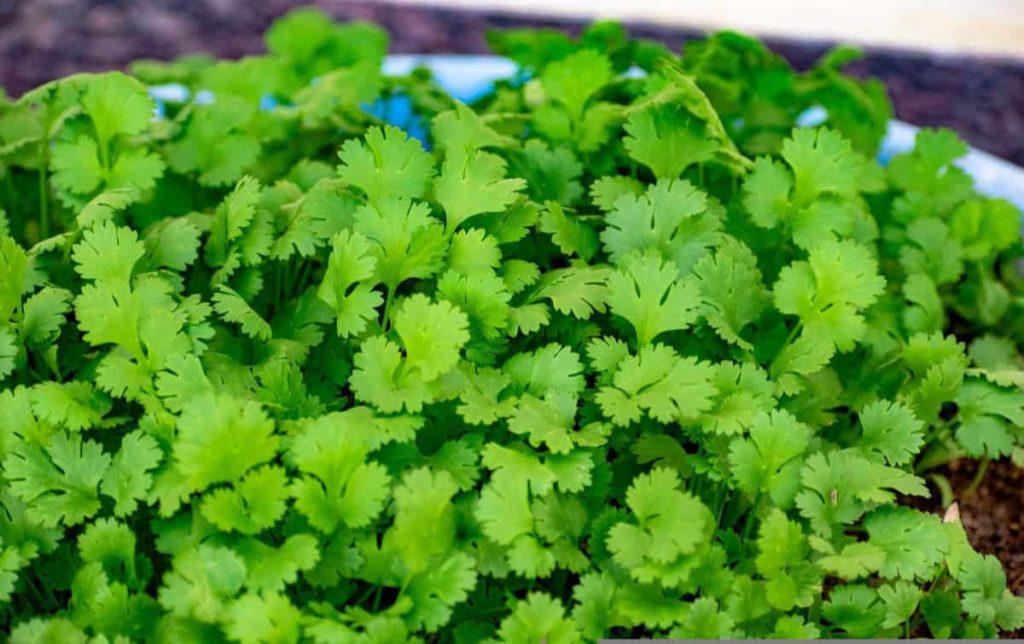
Does Cilantro grow better inside or outside?
- Cilantro is as delicious as a microgreen, or you can let it progress to maturity for a faster harvest. And for many gardeners, the herb grows better indoors than outdoors. So, if you’re looking for an excellent candidate to put your window in an herbal garden, consider Cilantro.
- Cilantro is an excellent herb for growing indoors, as full-size plants or microgreens. Plants require at least six hours of full sunlight or side light daily. They prefer temperatures between 10 to 26°C and moist potting soils.
Does Cilantro grow well in pots?
- Cilantro can be grown successfully in containers. Growing in containers can be much easier for a plant that tends to bolts. It allows you to move the plant around to shield it from too much heat.
- Select a bowl-shaped container at least 18 inches wide and 8 to 10 inches deep. Fill the pot with fast-draining potting soil; mix in organic granular fertilizer.
What kind of pot do you need to grow Cilantro?
- Most people choose too shallow pots for growing Cilantro, but that’s a mistake. Similar to Dill, Cilantro needs a pot that is deep and wide. For growing lush and full Cilantro in a container, choose one at least 8 inches deep. This would be a perfect size if you could get a window box or a large plastic tub.
- For growing in containers, you should consider a premium bagged potting mix. Keep the soil moist and use a soaker hose or drip irrigation if necessary. Encourage prolific leaf production by using water-soluble plant food. The pot you choose should have drainage holes at the bottom so the excess water can drain.
What can you not plant near Cilantro?
You should avoid planting fruit-bearing plants like Tomatoes and Peppers, as these don’t do well alongside the nitrogen-bearing plants you may be planting with your Cilantro. Good is to plant some tall annual flowers. Unfortunately, fennel tends not to be a good companion plant for most herbs, so keep it far from your Cilantro. Fennel secretes a substance that can inhibit the growth of Cilantro.
Why is Cilantro so difficult to grow?
- The main reasons for the Cilantro plant not growing are disease, overcrowding of plants, root-bound plants, overwatering or underwatering, and exposure to high temperatures. In addition, several environmental stresses and wrong growing practices will make these plants not grow properly.
- Besides pests and diseases, a common difficulty with Cilantro concerns its short growing cycle. Heat often causes Cilantro to bolt or start flowering and producing seeds. Grow Cilantro in a slightly shady spot.
What is the life cycle of Coriander?
In hot or warm weather, the life cycle of Cilantro is short. In the middle of summer, Cilantro will bolt into small lacy flowers, then set the seeds about four to six weeks from sowing. Cilantro will grow for several weeks to months before flowering and setting seeds on the cooler, shorter days of spring or autumn.
Why does my potted Coriander keep dying?
- Cilantro can be prone to pest attacks or diseases that deplete your crop or kill your plants. For example, beet armyworm and cabbage looper larvae eat Cilantro leaves, and feeding many of these larvae simultaneously can stop your plants’ growth or kill them.
- The cause of the dying Cilantro plant is usually drought due to too much sun, often no water, and rapid soil watering. However, too much water, too much nitrogen fertilizer, or a pot without drainage can cause the drooping of Cilantro leaves can turn yellow with a dying appearance.
In case you missed it: Growing Coriander From Seeds – (Cilantro) At Home
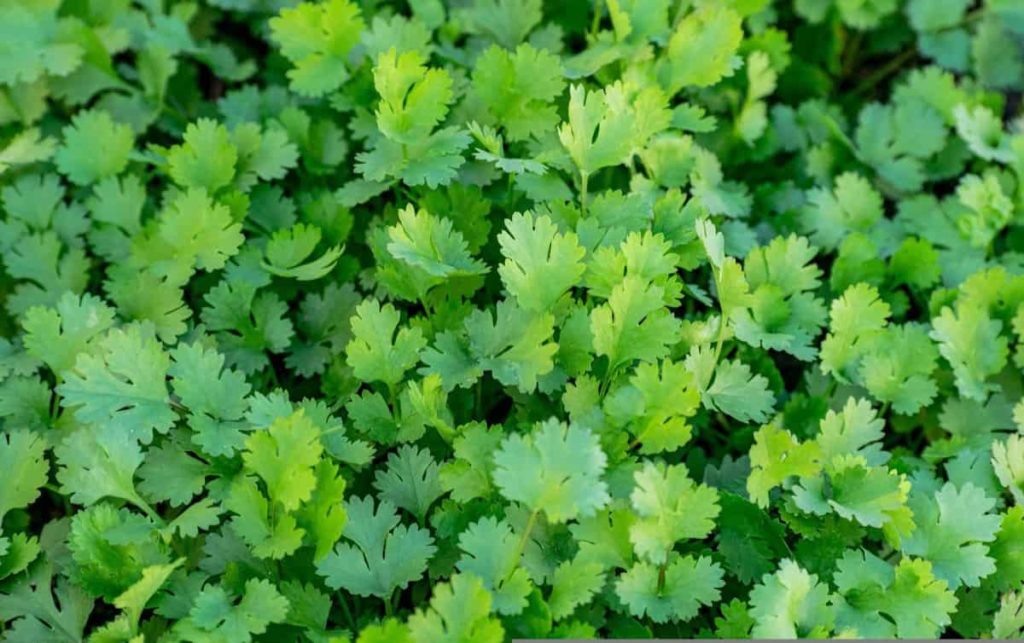
Why is my Coriander plant going brown?
If Cilantro turns brown or black, it could likely be due to excess water or root problems. Make sure the soil doesn’t water your Cilantro before it dries out; the Cilantro needs well-drained soil. Water well until the water exits the drainage holes. Keep the soil moist, and do not let it soak.
How many Cilantro seeds should I plant?
- Most seed packets contain schizocarp, so you’re planting two seeds as one. Let the heads of some seeds fall into the garden and harvested others. If you’re cutting Coriander seeds for saving, you can pick while the seeds are still green and dry them indoors, or allow them to dry on the plant before harvesting.
- Plant three Cilantro seeds per hole. Additional seeds meet the growth rate from 50% to 70%. Seedlings should sprout at 1 to 2 weeks.
What grows well next to Cilantro?
- Cilantro grows well near other herbs with similar water and full sun requirements, such as Basil, Parsley, and Chervil. You can even put these herbs together in an herbal garden container for accessible water. Basil, Mint, Yarrow, and Tansy are the best choices for co-planting with Cilantro.
What fertilizer is good for Cilantro?
- You should fertilize 1 or 2 times during the growing season by applying ¼ cup of nitrogen-based fertilizer per 25 square feet of growing area. However, beware of excessive fertilization; too much nitrogen can make the plant less flavorful.
- Don’t give any fertilizer to the Cilantro, but amend the soil with fertilizer before planting. Like any leafy plant, the Cilantro will bear a little shade but prefers full sun. Pinch the stems back and start using the leaves as soon as possible. This will help prevent plants from flowering very quickly.
- Use organic fertilizer for organic Cilantro or fortify the soil with compost. Feeding the herb once a month.
- You can fertilize them whenever you water. This will give them the boost they need to produce a lot of edible leaves. Once the flowers appear and the plants start setting seeds, you can stop using fertilizer.
What month do you plant Coriander?
- Coriander is sown from late March to early September. You should sow small quantities every three weeks to get a steady supply of leaves through summer.
- The plant needs rich, well-drained soil and a moderate amount of water. Sow at the full sun location for the best yield in loam or sandy soil.
- It is a tropical crop and can be grown throughout the year for leaf purposes, but it has to be grown in a specific season for a higher grain yield.
Can you plant Cilantro in potting soil?
- Cilantro prefers light, well-drained, moderately fertile loam or sandy soil, but it will tolerate many soils as long as nutrient levels and humidity are monitored.
- Grow Cilantro in a site that receives full sun and has rich, well-drained soil with a pH of 6.2 to 6.8. Offer an afternoon shade if you live in a warmer climate. Improve the local soil by mixing in several inches of aged manure or other rich organic matter. To grow in containers, consider a premium bagged potting mix.
How much does Cilantro yield?
There is a lot of difference in production depending on the location. The average coastal annual output is 8 to 11 tons per acre. Cilantro is cut by hand and sold in bunches that are used as fresh herbs and machine-cut and sold in bulk for food service or processing.
Can you grow Cilantro close together?
The trick to getting a full Cilantro harvest from a container is planting several plants very close together. Instead of diluting each plant to a distance of about six inches, as you do in the ground, you want to grow the container Cilantro very densely. A wide, very deep container is ideal for Cilantro.
In case you missed it: Growing Coriander In Backyard At Home
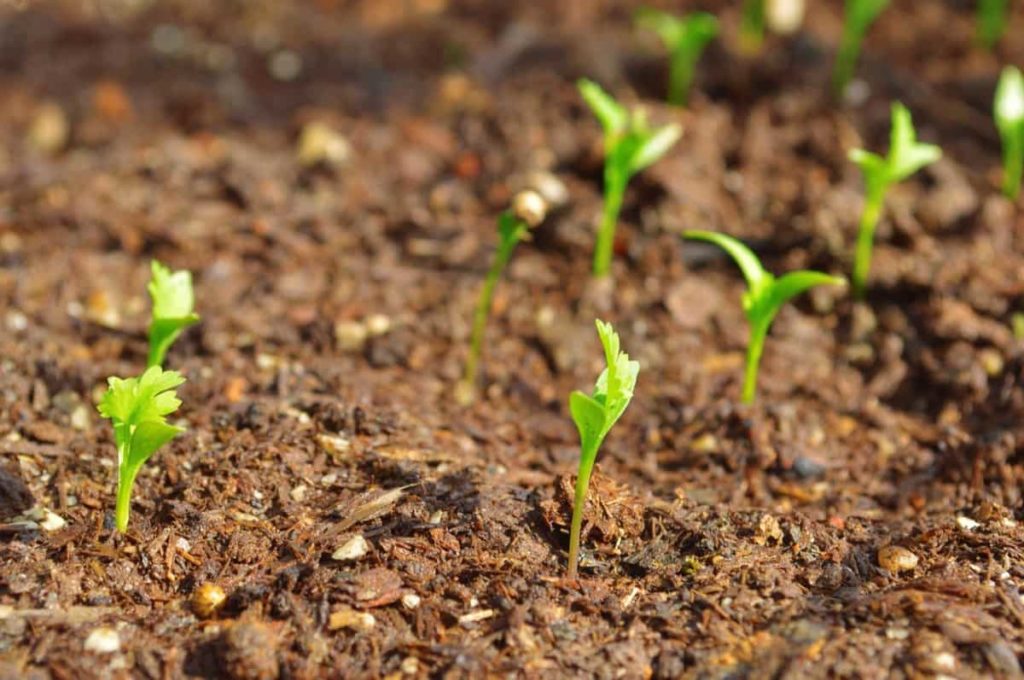
Conclusion
Cilantro is a very versatile herb because you can use every part of the plant for cooking, so learning to grow Cilantro will allow you to harvest the whole crop from root to flower. In addition, growing close to the kitchen, you can taste a plant at all stages of its development: Cilantro leaves, flowers, green seeds, and dried seeds all taste very different.
- Flower Garden Designs and Layouts for Beginners
- Planting and Spacing Techniques in Papaya: A Beginner’s Guide
- Growing Gold: Essential Techniques for Planting Pineapples
- How to Make Kalanchoe Plant Bushy: Home Remedies and Solutions
- 11 Reasons Why Your Gardenia is Not Blooming: Home Remedies and Solutions
- Eco Elegance: The Guide to Designing a Drought-Tolerant Landscape
- Gardening on a Slope: Strategies for Hillside Landscaping
- Nourish and Flourish: Top Organic Mulches for Thriving House Plants
- Everything You Want to Know about Indian Mogra Flower: Discover Uses and Growing
- Green Thumb Success: Expert Tips for Cultivating Greenhouse Pumpkins All Year Round
- Maximize Growth & Flavor: The Ultimate Guide to Companion Planting in Herb Gardens
- How to Control Rhododendron Problems Naturally: Home Remedies and Organic Ways to Fix Them
- Natural Magic: The Remarkable Benefits of Cinnamon for Plants
- Best Steps to Revive Dying Tulip with Natural and Organic Treatment
- 10 Reasons Why Your Angel Trumpet is Not Blooming: Remedies and Treatment
- How to Fix Periwinkle Leaf and Flower-Related Problems: Natural Remedies and Solutions
- How to Fix Zinnias Leaf and Flower Problems: Discover Natural and Home Remedies
- Organic Steps to Induce Lemon Tree Flowers: A Comprehensive Guide
- Bloom Booster: Crafting the Perfect Homemade Bougainvillea Fertilizer
- Optimizing Growth: A Guide to Applying NPK Fertilizer for Potted Plants
- 10 Best Homemade Fertilizers for Rubber Plant: DIY Recipes and Application Method
- How to Boost Female Pumpkin Flowers: Effective Steps for More Flowers and High Yields
- Transform Your Indoor Garden: Top Benefits of Pink Salt for Houseplants
- 10 Best Homemade Fertilizers for Peacock Plants (Calathea): Easy DIY Guide
- Unlock Blooms: 9 Reasons Why Your Potted Chrysanthemum is Not Blooming
- 8 Reasons Why Your Potted Hibiscus is Not Blooming: Fix it with Simple Solutions
- Unlock Blooms: 9 Key Reasons Your Potted Frangipani Won’t Flower
- 10 Reasons Why Is My Ice Plant Not Blooming: Remedies and Treatment
- 10 Reasons Why My Potted Hydrangea Not Blooming: Treatment and Remedies
- 10 Reasons Why is My Wisteria Not Blooming: Remedies and Treatment
- 10 Reasons Why is My Goldfish Plant Not Blooming: Remedies and Treatment
- Maximize Your Space: Ultimate Guide to Balcony Gardening with Grow Bags
- 10 Reasons Why Your Iris is Not Blooming: Remedies and Treatment
- 10 Reasons Why Your Anthurium Plant is Not Blooming: Treatment and Remedies
- 10 Reasons Why Your Aquaponic Plants Are Not Flowering: Remedies and Treatment
- 10 Reasons Why Your Agapanthus is Not Flowering: Remedies and Treatment